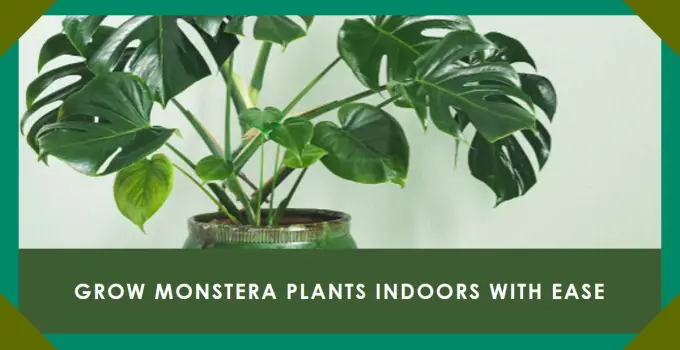Patio Paradise 8' x 12' Sun Shade Sail Waterproof Gray Rectangle Shade Canopy UV Block Tarp Cloth Outdoor Patio Cover for Garden Backyard Deck Awning
$37.98 ($0.40 / square feet) (as of December 28, 2025 01:04 GMT +00:00 - More infoProduct prices and availability are accurate as of the date/time indicated and are subject to change. Any price and availability information displayed on [relevant Amazon Site(s), as applicable] at the time of purchase will apply to the purchase of this product.)birdsnap® PAV-Bird Feeder with Camera,2K HD with 64GB Card, AI Identify Smart Bird House Cam Solar Panel,Live Stream,Motion Detection,Auto Record Video for Backyard Outdoors,Ideal Gift for Bird Lover
40% OffTop 25 Surprising Benefits of Growing Monstera Plants Indoors
Are you looking to add some life and vitality to your indoor space? Look no further than the monstera plant – a tropical beauty with broad, unique leaves and an easy-going nature that makes it perfect for both beginners and experienced green thumbs alike.
More than just a pretty face, monstera plants offer a wide range of surprising benefits when grown indoors. From boosting air quality to increasing focus and productivity, these lush vines can be therapeutic sanctuaries in your own home or office.
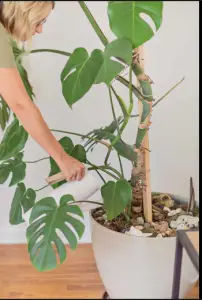
In this comprehensive guide, we’ll delve deep into the top 25 benefits of growing monstera plants indoors. Get ready to be amazed by the natural power of this incredible houseplant as we explore its air purifying abilities, aesthetic appeal, medicinal uses, and so much more. Let’s turn your space into an urban jungle oasis!
Benefit #1: Improves Indoor Air Quality
We all want to breathe clean, fresh air indoors – and monstera plants are expert air purifiers that can help achieve just that. These tropical beauties absorb and filter out common toxins found in indoor environments like:
- Formaldehyde
- Benzene
- Trichloroethylene
- Xylene
Their broad leaves have microscopic pores that act like a natural filtration system, trapping airborne pollutants and toxins. Monstera plants then metabolize these harmful compounds and release pure oxygen back into the air through photosynthesis.
Keeping several thriving monstera plants around the home or office can make a major difference in air purity levels, reducing stuffiness and creating a healthier, more pleasant environment. The end result is crisp, revitalizing air that promotes respiratory health.
Benefit #2: Enhances Mental Focus and Productivity
In our fast-paced, digital world it’s easy to get distracted and lose focus. Luckily, monstera plants can actually help improve concentration and boost productivity naturally.
The mere presence of living greenery has been shown to:
- Reduce stress and anxiety
- Improve mood
- Stimulate creativity
- Increase attentiveness
By incorporating monstera plants into your workspace or home office, you create a soothing, calming environment that fosters mental clarity. Their glossy green leaves and fenestrated patterns are visually captivating, yet not overly distracting. This allows you to settle into a focused flow state and tackle tasks more efficiently.
For an extra productivity boost, place a monstera plant within your line of vision while at your desk or workstation. Its nearby natural presence can increase attention span, leading to higher-quality work output.
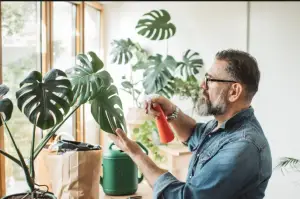
Benefit #3:
Noise Reduction Noisy indoor environments can be a major source of stress and distraction, making it difficult to concentrate or relax. Enter monstera plants – natural sound absorbers that help dampen excess noise.
The soft, broad leaves of monstera plants can absorb and diffract sound waves, reducing acoustic reverberation. This provides a muffling effect on ambient noises like traffic, appliances, music, and voices in adjacent rooms. The end result is a more peaceful, tranquil environment.
Incorporate several robust monstera plants strategically around noise problem areas in your home or workspace. You’ll be amazed at how much quieter and more serene the atmosphere becomes!
Benefit #4: Boosts Mood and Relieves Stress
In today’s high-pressure world, it’s more important than ever to find healthy ways of managing stress. Studies show surrounding yourself with living greenery like monstera plants can provide a drug-free mood boost and stress relief.
Exposure to plants has been scientifically proven to:
- Lower blood pressure
- Reduce anxiety and feelings of tension
- Increase feelings of calm and optimism
The therapeutic effect monsteras have on our psyche may relate to our innate biophilia – the human tendency to feel connected to nature and living systems. By bringing these luxuriant plants indoors, you recreate a nurturing, life-affirming environment that relaxes the mind.
Come home after a long workday and submerge yourself in a lush, indoor jungle of monsteras. As you care for these resilient plants and watch them thrive, it’s impossible not to absorb some of their serene, growth-oriented energy.
Benefit #5: Improves Sleep Quality
Do you have difficulty falling or staying asleep at night? Surrounding yourself with monstera plants is a natural way to promote better sleep hygiene.
Monsteras give off oxygen at night through respiration, filtering stale indoor air and replenishing it with rejuvenating fresh oxygen. This oxygen-rich environment makes for deeper, more restorative sleep.
Additionally, their natural humidity regulation helps prevent excessively dry air that can irritate airways and prevent restful sleep. Monsteras’ large leaves absorb excess moisture when conditions get too humid.
Finally, the lush foliage and gentle rustling of leaves creates soothing natural white noise. This can mask chronic sleep disruptors like outdoor traffic, while promoting a sense of relaxation and calm perfect for sleeping.
For best sleep benefits, keep a few modest monstera plants in your bedroom. Just be sure to leave some space between the plants and the bed to prevent pests from reaching you while sleeping.
Benefit #6: Therapeutic Benefits for Mental Health
Beyond improving sleep and mood, monstera plants offer proven therapeutic benefits that enhance mental wellbeing. Multiple studies have confirmed houseplants like monsteras can:
- Significantly reduce anxiety and tension
- Provide a sense of comfort and relaxation
- Elevate positive feelings and self-esteem
- Promote recovery from mental fatigue
The mere act of tending to houseplants can be mentally restorative. Engaging with the natural life cycle of growth provides a sense of accomplishment, perspective, and peace of mind. Monstera plants in particular, with their unique leaf patterns, resilience, and propensity to thrive indoors, make ideal therapeutic companions.
For those suffering from conditions like depression or burnout, reconnecting with nature through indoor plants can help restore balance and recenter the mind. Monstera plants’ verdant, thriving presence helps counteract feelings of apathy or disconnection.
Benefit #7: Safer Than Cut Flowers for Allergy Sufferers
Breathing in pollen and airborne allergens from fresh flowers can trigger allergy and asthma symptoms. Monstera plants, however, offer a safer alternative way to bring nature indoors if you suffer from these conditions.
Monsteras release almost no allergens or pollen when grown indoors, as they don’t flower often under home conditions. Their leaves also gather less dust and dander than cut flowers.
For allergy sufferers, monsteras provide a pollen-free way to experience the benefits of indoor greenery. Just be sure to give the leaves a gentle dusting with a microfiber cloth every now and then.
Benefit #8: Natural Humidity Regulation
Excessively dry indoor air can cause a host of health and comfort issues, including:
- Itchy, cracked skin
- Eye irritation
- Respiratory problems
- Damage to wooden furnishings
Fortunately, monstera plants act as natural humidifiers, passively releasing moisture into the air through their stomata and leaves. This helps maintain optimal indoor humidity levels of about 30-50%.
Their broad leaves are also highly effective at absorbing excess humidity when conditions get too damp. This two-way humidity regulation prevents the growth of allergens like mold and dust mites that thrive in overly moist environments.
Place several large, mature monstera plants strategically around rooms prone to dryness to help balance indoor humidity. This natural approach is safer than chemical humidifiers and provides the bonus benefit of fresh oxygen!
Benefit #9: Enhances Decor and Ambiance
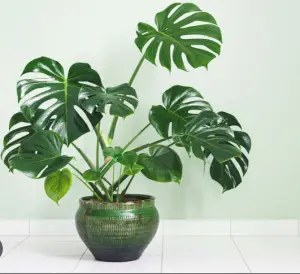
Monstera plants aren’t just therapeutic and practical – they make incredibly stylish and visually impactful indoor design statements too. With their unique leaf patterns and climbing vines, monsteras bring an exciting, lush, tropical flair to any indoor space.
These plants blend seamlessly into virtually all decor styles, from minimalist modern to eclectic bohemian. Their foliage has eye-catching sculptural qualities, with large split leaves and distinctive fenestrations that add color, texture, and striking lines.
Vining varieties like monstera deliciosa can be trained up moss poles or trellises to create living room dividers or dramatic backdrops behind seating areas. Their trailing vines can also be allowed to elegantly cascade down from shelves or hanging baskets. It’s a perfect way to introduce energizing vertical greenery.
Want to embrace the trendy urban jungle aesthetic? Combine several robust monstera varieties together with other large tropical plants like rubber trees or philodendrons. Their lush layered foliage will transform your space into a botanical paradise.
Benefit #10: Beginner-Friendly, Low Maintenance
Keeping houseplants alive and thriving can seem daunting, especially for beginners. Monsteras, however, offer an ideal entry point for budding plant enthusiasts due to their hardy, low-maintenance nature.
Native to the tropical forests of Central and South America, monsteras have evolved to be incredibly resilient. Once established, they can tolerate short periods of drought, low humidity, and less-than-ideal lighting conditions that would leave other plants looking sad and sickly. And they’re highly resistant to most common plant pests and diseases.
Monsteras make an excellent starter houseplant for novice gardeners learning about:
- Proper watering schedules
- Lighting needs
- Humidity and temperature preferences
- Fertilizing requirements
Since monsteras give clear signs when their needs aren’t being met, it provides a great learning experience. Their hardy constitution also means there’s plenty of room for error. Monsteras forgive occasional missed waterings better than most!

Benefit #11: Pests and Disease Resistant
No indoor gardener wants to deal with battling infestations of aphids, spider mites, whiteflies, and other common houseplant pests. Luckily, monstera plants have a natural resilience that helps prevents these issues.
Monsteras are native to tropical rainforests where they compete for resources. Over time, they’ve evolved natural defenses and robust immune systems to withstand pests, diseases, and periods of drought.
Their thick, waxy leaf texture provides a first line of defense that makes them less susceptible to sap-sucking insects. They’re also remarkably hardy against fungal infections and root rots compared to many houseplants.
Of course, prevention is key. Follow proper plant care:
- Provide ideal lighting and humidity
- Don’t overwater
- Quarantine new plants
- Wipe leaves periodically with a damp cloth
With just a bit of basic care, vigorous monstera plants rarely have serious disease or pest problems indoors. This makes them a hassle-free choice compared to more fragile houseplants.
Benefit #12: Effortless Propagation
Starting new houseplants from cuttings is both satisfying and a great way to build up plant collections. Monstera plants are particularly easy to propagate using either stem or air root cuttings.
Monsteras naturally send out aerial roots and produce new growth points along their stems. All you need to do is carefully snip a stem section with a few leaves and air roots attached and place it in either water or a moist soil medium.
Before long, new roots will emerge and eventually new shoots will form. After allowing the new plant to mature a few months, you can pot it up and enjoy the result of your propagation success! Many monstera keepers find they end up with so many propagated babies they can give them away to friends and family.
Propagating monstera plants is also a perfect way to learn about plant anatomy, growth cycles, and propagation techniques while virtually guaranteeing success. It’s a fun, inexpensive way to expand your indoor garden.
Benefit #13: Versatility and Variety
One of the most impressive things about monstera plants is the sheer number of unique varieties available with different leaf shapes, sizes, colors, and growth habits. This gives you ample options to find the perfect specimen to suit your personal aesthetic and interior space.
Some of the more common varieties include:
- Monstera deliciosa – The classic with large, split leaves
- Monstera adansonii – Features smaller, rounder perforated leaves
- Monstera obliqua – More compact with elongated holes
- Variegated monsteras – Leaves with patches of white and green
- Monstera siltepecana – Unusual lobed leaf form
- Monstera dubia – More narrow, swordshaped leaves
You can even find miniature, dwarf, and climbing growth habits for different uses. Smaller, contained varieties make ideal tabletop plants while robust vining forms are great for training.
This versatility provides endless opportunities to express your creativity. Mix and match different monstera varieties for intriguing visual contrast and depth. Incorporate them as both floor and tabletop specimens. Drape vines along shelves or allow them to trail down from hanging baskets. The possibilities are endless!
Benefit #14: Symbolic Meaning in Feng Shui
Monstera plants carry symbolic meaning in the ancient Eastern practice of Feng Shui – the art of arranging environments to promote positive life energy or “chi.” Here monstera plants represent:
- Flexibility and adaptability
- Perseverance and strength
- Interconnection with nature
- Harmony and balance
Adding monstera plants, with their hardy, adaptable nature, to living or working environments is said to help cultivate those same qualities in ourselves. Their persistent growth through the seasons reminds us to stay resilient and embrace change.
In Feng Shui, monsteras are also associated with the wood element, representing new beginnings, creativity, and rebirth. Placing these plants in the East, Southeast, or Family areas of the home is thought to remove staleness and infuse new energy into relationships and living spaces.
Whether you personally subscribe to Feng Shui or not, monsteras undeniably carry a positive, nurturing life force. Their adaptability and unassuming persistence makes them ideal plant allies to have around.
Benefit #15: Lightweight and Portable
Due to their lightweight epiphytic nature, monstera plants can make excellent temporary botanical accents for events, parties, and other indoor spaces. Simply pop them out of their nursery pot and place in an attractive container.
Their low maintenance care requirements mean they can easily travel with you from venue to venue. Monsteras only need infrequent watering and aren’t overly fussy about lighting conditions for short periods.
Use well-established monstera specimens as centerpieces or create a verdant oasis around seating areas at your next event. Their eye-catching foliage is sure to impress guests!
Benefit #16: Boosts Productivity in Offices
Incorporating living greenery like monstera plants into office environments is a science-backed way to improve employee productivity, focus, and wellbeing.
Multiple studies from the early 1990s onward have demonstrated the positive effects of houseplants on workplace performance:
- Increased concentration and ability to focus
- Reduced stress and anxiety
- Higher job satisfaction
- Decreased absenteeism
- Faster recovery from mental fatigue
Experts theorize these productivity boosts result from both the air-purifying effects of plants and the restorative impact of natural aesthetics on the human psyche.
Adding a few large specimen monstera plants around clusters of desks, in lobbies, breakrooms, and gathering areas is an easy, low-cost way to upgrade the functionality of any office space.
Plants can also help reduce noise and create a sense of privacy in open office floor plans. Their presence helps diffuse sound so voices and other noises don’t travel as far.

Benefit #17: Thrives in Low Light
While monstera plants do best in bright, indirect sunlight, one major benefit is they can adapt to survive in relatively low light conditions compared to other species.
This quality makes monsteras a stellar choice for interior rooms without large sunny windows or north-facing exposures. Simply place your plants near an east or west window and they should perk along just fine.
Consistent bottom watering helps offset any stretching of new leaves in lower light conditions. And using grow lights or a full-spectrum desk lamp can help supplement sun exposure if needed.
Just avoid placing monstera plants in areas with no natural daylight at all. Over time, they’ll lose their lush, vibrant green foliage and become leggy and weak without any sun exposure.
Benefit #18: Medicinal and Therapeutic
Uses In addition to their modern benefits, monstera plants have a rich history of traditional medicinal and therapeutic uses in their native rainforest habitats.
In southern Mexico, healers used monstera as a remedy for painful conditions like arthritis and rheumatism by grinding the aerial roots into beverages. The leaves and stem sap were also applied topically to treat insect bites, burns, and wounds.
There’s also some evidence that extracts from monstera plants contain antioxidant compounds and may have anti-inflammatory, antimicrobial, and analgesic properties.
While more research remains to be done, you could consider making monstera part of your approach to herbal and complementary medicine. Its therapeutic powers may be as boundless as the rainforests it hails from!
Benefit #19: Natural Humidifier
As we touched on earlier, monstera plants are natural humidity regulators that can help achieve optimal humidity levels indoors. Specifically, their large leaves passively release moisture into the air through exposed stomata on the undersides.
This creates a localized humidifying effect, similar to misters and evaporative humidifiers, but without the noise, maintenance requirements, or risk of mineral dust and bacteria. The added moisture makes the air feel fresher and more comfortable to breathe.
Strategically place large, robust monsteras around dry areas prone to overly low humidity, like near heating vents or in rooms with hardwood floors. You’ll quickly notice the difference in moisture levels and air quality.
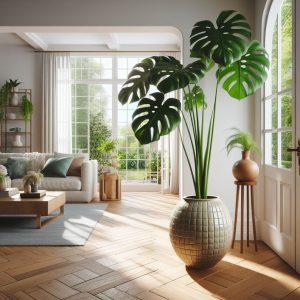
Benefit #20: Oxygen Release at Night
Beyond their air-purifying and humidity regulation abilities, monsteras offer another benefit – they release fresh oxygen into the air even at night through respiration!
During daylight hours, all plants release oxygen as a byproduct of photosynthesis. But at night, photosynthesis stops while respiration continues, resulting in a slight oxygen deficit.
Monstera plants are one of the few houseplants that continue transpiring and passively releasing oxygen after the sun goes down. This provides a much-needed refresh of stale indoor air.
Consider keeping a potted monstera or two in bedrooms to take advantage of this around-the-clock oxygen production. It promotes better sleep quality and general respiratory health.
Benefit #21: Easy Tolerance of Drought
Monsteras are tropical plants that in nature grow as epiphytes on tree trunks and branches. Their natural habitat of sporadic rainfall has endowed them with excellent drought tolerance.
When all their basic needs are met, monsteras prefer consistently moist soil. But if you miss a scheduled watering or accidentally let the soil dry out between waterings, they usually handle it without major issues.
Their leathery leaves and thick cuticle help prevent excessive water loss. And their aerial roots can absorb condensation from humid air if needed during dry spells.
This drought hardiness makes monsteras ideal for busy plant parents who travel frequently or might not always be super consistent about watering schedules. You’ll have some extra flexibility and peace of mind knowing your plants are unlikely to keel over from the occasional missed watering.
Benefit #22: Produces Edible Fruit
It may surprise you to learn that in addition to being superb houseplants, some monsteras can also produce tasty edible fruit indoors given the right conditions!
The edible monstera deliciosa variety bears oblong, cone-shaped fruits that weigh up to 3 pounds when mature and ripen to a creamy yellow color. The sweet flesh inside has been described as tasting like a combination of pineapple, banana, and mango.
To encourage fruit production indoors, you’ll need to provide ample bright light, humidity, and warmth. Mature specimen plants also respond well to selective pruning and vegetative growth hormone sprays to stimulate flowering and fruiting.
Just be careful to only consume fruit from monstera deliciosa plants, as fruits of other monstera species like monstera adansonii contain insoluble calcium oxalate crystals and are toxic.
Benefit #23: Supports Plant Biodiversity
Preserving plant biodiversity globally by growing tropical plants like monsteras indoors may seem like a small gesture, but it connects us to wider ecological issues.
Many monstera species, including the popular deliciosa variety, face threats in their natural rainforest habitats from deforestation, industrial agriculture, and development. While propagated houseplant forms don’t represent pure genetic stock, they help educate people about lesser known species outside of botanized environments.
The familiarity and exposure fostered by widespread houseplant cultivation helps raise awareness and appreciation for monstera’s conservation. It also supports the nursery trade and creates economic incentive to preserve monstera diversity.
So by growing and enjoying the unique monstera plants indoors, you become part of the global grassroots movement working to protect the resiliency and richness of plant life on Earth. Each urban jungle contributes to the greater whole.
Benefit #24: Easy Care Seasonal Transitions
One of the best parts about keeping monstera plants is how they adapt and transition seamlessly through seasonal changes without major interventions required.
Once established in a spot with adequate light, temperature, humidity, and watering, monsteras can more or less regulate themselves as the year progresses. As daylight hours decrease and temperatures drop in fall and winter, their growth naturally slows. Provided you match their water needs, there’s little risk of serious issues.
Come spring, the plant recognizes more favorable conditions and resumes vigorous growth and new leaf production. Giving your plant a gentle trim in early spring also encourages lush new leaf development.
You don’t need to worry about strictly controlling day/night cycles, photoperiods, winter dormancy, or other exacting requirements like some plants. Monsteras thrive on simple, consistent care through the seasons.
Benefit #25: Invokes the Rainforest
Lastly, growing monstera plants indoors connects us to the lush, verdant essence of tropical rainforests, one of Earth’s most awe-inspiring biomes. Even a single mature specimen evokes the verdant dappled canopy of the Amazonian jungles it natively calls home.
There’s a primal energy and wildness to monsteras with their bold fenestrated leaves and sprawling growth habits not found in many common houseplants. Just studying the intricate geometric patterns of their leaf fenestrations, you can practically sense their rainforest DNA and evolutionary journey.
Surrounding yourself with monsteras (along with other compatible tropical plants like philodendrons and snake plants) transports your senses to a primeval forest sanctuary. It’s a lush, overgrown oasis to escape the stresses of modern life and reconnect with nature in an intimate, nurturing way.
Bonus – Care Tips for Thriving Monstera Plants To wrap up this guide, let’s review some key cultivation tips to keep your monstera plants thriving indoors:
- Lighting – Bright, indirect sunlight near an east or south-facing window is ideal. Avoid hot direct sun.
- Watering – Allow the top 1-2 inches of potting mix to dry between waterings, then water thoroughly until it drains out the bottom. Provide humidity through misting or pebble trays.
- Potting Mix – Use a well-draining potting mix with ingredients like orchid bark, perlite, and coir that allows roots to dry slightly between waterings.
- Temperature – Daytime temperatures between 70-85°F are perfect, with cooler 60-75°F temps at night. Ensure consistent warmth year-round.
- Fertilizer – Feed with a balanced liquid fertilizer every 1-2 months during the active growing season (spring through fall) to nourish new growth.
- Pruning/Training – Prune off dead growth and aerial roots. Use moss poles or trellises to train vining growth up and create more vertical displays.
- Repotting – Repot yearly in spring using a container 2-3 inches wider than the previous. This prevents roots from becoming rootbound.
Follow these simple tips and you’re sure to enjoy thriving, lush monstera plants that provide maximum benefits for years to come! Happy growing!

